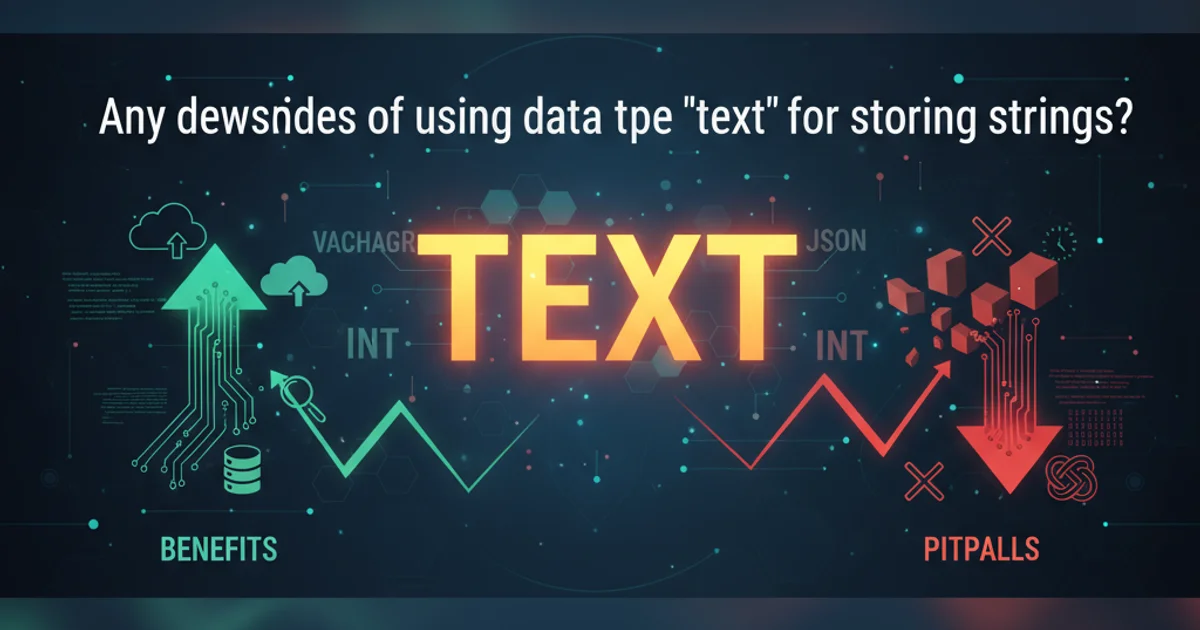Any downsides of using data type "text" for storing strings?
Understanding the 'TEXT' Data Type in PostgreSQL: Downsides and Best Practices

Explore the implications of using the 'TEXT' data type for storing strings in PostgreSQL, covering performance, storage, and indexing considerations.
PostgreSQL offers a variety of data types for storing character strings, including VARCHAR(n), CHAR(n), and TEXT. While TEXT is often seen as a convenient choice due to its lack of a predefined length limit, it's crucial to understand its characteristics and potential downsides. This article delves into the nuances of using the TEXT data type, helping you make informed decisions for your database schema design.
Storage and Performance Characteristics
Unlike VARCHAR(n) which enforces a maximum length, TEXT columns can store strings of virtually any length (up to 1 GB in PostgreSQL). This flexibility comes with certain storage and performance implications. PostgreSQL handles TEXT and VARCHAR internally in a very similar manner; both are variable-length types. The primary difference lies in the explicit length check for VARCHAR(n) at insertion time. For very long strings, PostgreSQL employs a technique called TOAST (The Oversized-Attribute Storage Technique) to store data out-of-line, which can affect performance.
flowchart TD
A[Insert Data into TEXT Column]
B{Is Data Length > TOAST Threshold?}
C[Store Data In-line]
D[TOAST Data Out-of-line]
E[Retrieve Data from TEXT Column]
F{Is Data TOASTed?}
G[Retrieve In-line Data]
H[De-TOAST and Retrieve Out-of-line Data]
A --> B
B -->|No| C
B -->|Yes| D
E --> F
F -->|No| G
F -->|Yes| HPostgreSQL TOAST Mechanism for Large TEXT Data
When a TEXT column's data exceeds a certain threshold (typically 2KB), PostgreSQL compresses and/or moves the data to a separate TOAST table. This process is transparent to the user but introduces overhead. Retrieving TOASTed data requires an extra lookup, which can slightly increase I/O operations and CPU usage, especially when dealing with many large TEXT values. However, for typical string lengths, the performance difference between TEXT and VARCHAR is often negligible.
Indexing and Query Performance
Indexing TEXT columns is possible, but it's important to consider the implications. A standard B-tree index on a TEXT column will index the entire string. If these strings are very long, the index itself can become very large, consuming significant disk space and potentially slowing down index scans. For full-text search capabilities, a TEXT column is typically used in conjunction with a tsvector column and a GiST or GIN index, which are optimized for such operations.
CREATE TABLE articles (
id SERIAL PRIMARY KEY,
title VARCHAR(255) NOT NULL,
content TEXT
);
-- Creating a standard B-tree index on a TEXT column
CREATE INDEX idx_articles_content ON articles (content);
-- Creating a functional index for the first N characters (e.g., 255)
CREATE INDEX idx_articles_content_prefix ON articles (SUBSTRING(content FOR 255));
Examples of indexing TEXT columns in PostgreSQL
TEXT columns that are frequently searched or filtered, consider creating a functional index on a prefix of the string (e.g., SUBSTRING(column_name FOR N)) if searches are typically on the beginning of the string. Alternatively, for full-text search, use PostgreSQL's built-in full-text search features with tsvector and appropriate indexes.Schema Clarity and Data Integrity
While TEXT offers flexibility, it can sometimes lead to less explicit schema definitions. When a string has a natural maximum length (e.g., a person's name, an email address, a URL), using VARCHAR(n) provides a clear indication of expected data size and enforces this constraint at the database level. This can help prevent accidental insertion of overly long strings that might be truncated or cause issues in application layers expecting shorter data. The lack of a length constraint in TEXT means that applications are solely responsible for managing string lengths, which can lead to inconsistencies if not handled carefully.
TEXT for all string data can obscure the intended data characteristics. If a string has a well-defined maximum length, VARCHAR(n) can improve schema clarity and data integrity by enforcing that constraint at the database level, preventing application-level bugs related to unexpected string lengths.In conclusion, the TEXT data type in PostgreSQL is a powerful and flexible option for storing strings of varying lengths. For most common use cases, its performance is comparable to VARCHAR. However, for extremely long strings, be aware of the TOAST mechanism's overhead. For columns with a known maximum length, VARCHAR(n) can offer better data integrity and schema clarity. The choice between TEXT and VARCHAR often boils down to whether an explicit length constraint is beneficial for your application's data model and integrity requirements.